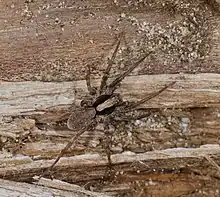| Xerolycosa nemoralis | |
|---|---|
 | |
| Female | |
| Scientific classification | |
| Domain: | Eukaryota |
| Kingdom: | Animalia |
| Phylum: | Arthropoda |
| Subphylum: | Chelicerata |
| Class: | Arachnida |
| Order: | Araneae |
| Infraorder: | Araneomorphae |
| Family: | Lycosidae |
| Genus: | Xerolycosa |
| Species: | X. nemoralis |
| Binomial name | |
| Xerolycosa nemoralis | |
| Synonyms[1] | |
| |
Xerolycosa nemoralis, or the burnt wolf spider,[2] is a species of wolf spider found from western Europe eastwards to the Pacific.
Description
The male has swollen palpal bulbs which are as long as they are wide at the base. The grooves on the genital shield are wider than they are long. The prosoma is brown, with a bright median stripe, which has parallel margins with white hair. The sternum is dark brown and the legs are a uniform dark brown, almost black. The opisthosoma is dark brown with a slightly darker cardiac spot.[3]
The males are 4.5–5.7 millimetres (0.18–0.22 in) in length, the larger females 5–7.5 mm (0.20–0.30 in).[3]

Habitat and ecology
The spider lives in dry litter and bark in sunny coppiced areas or clearings in woods, on stony chalk grassland with a short sward, on burnt heathland (up to approximately four years after the heath has been burnt) or bare patches of ground in older heathland. X. nemoralis has occurred in large numbers in sparsely vegetated man-made sites, such as railway ballast, almost to the exclusion of other wolf-spiders.[4] In mainland Europe, it can be found on the sunny edges of coniferous forest up to 1800 m above sea level.[3] Female Xerolycosa nemoralis are known to excavate shallow depressions in soil.[5]
In Britain, X. nemoralis is active from late March through the summer to mid-September. The males emerge earlier than the females and the last specimens in Autumn are females.[4]
Distribution
X. nemoralis is widely distributed in Europe from south eastern England[4] east to Russia.[6] And across the Palearctic[1] to Kamchatka and Honshu, south as far as Azerbaijan.[5]
References
- 1 2 3 "Taxon details Xerolycosa nemoralis (Westring, 1861)". World Spider Catalog. Natural History Museum Bern. Retrieved 2016-08-28.
- ↑ "Xerolycosa nemoralis". Stefan Sollfors, Eurospiders.com. Retrieved 27 August 2016.
- 1 2 3 "Xerolycosa nemoralis (Westring, 1861)". www.araneae.unibe.ch. Retrieved 27 August 2016.
- 1 2 3 "Summary for Xerolycosa nemoralis (Araneae)". British Arachnological Society. Retrieved 27 August 2016.
- 1 2 Marusik, Yuri M.; Kovblyuk, Mykola M.; Koponen, Seppo (2011). "A survey of the East Palaearctic Lycosidae (Araneae). 9. Genus Xerolycosa Dahl, 1908 (Evippinae)". ZooKeys (119): 11–27. doi:10.3897/zookeys.119.1706. PMC 3192426. PMID 21998514.
- ↑ "Xerolycosa nemoralis (Westring, 1861)". Museum für Naturkunde Leibniz-Institut für Evolutions und Biodiversitätsforschung. Retrieved 27 August 2016.